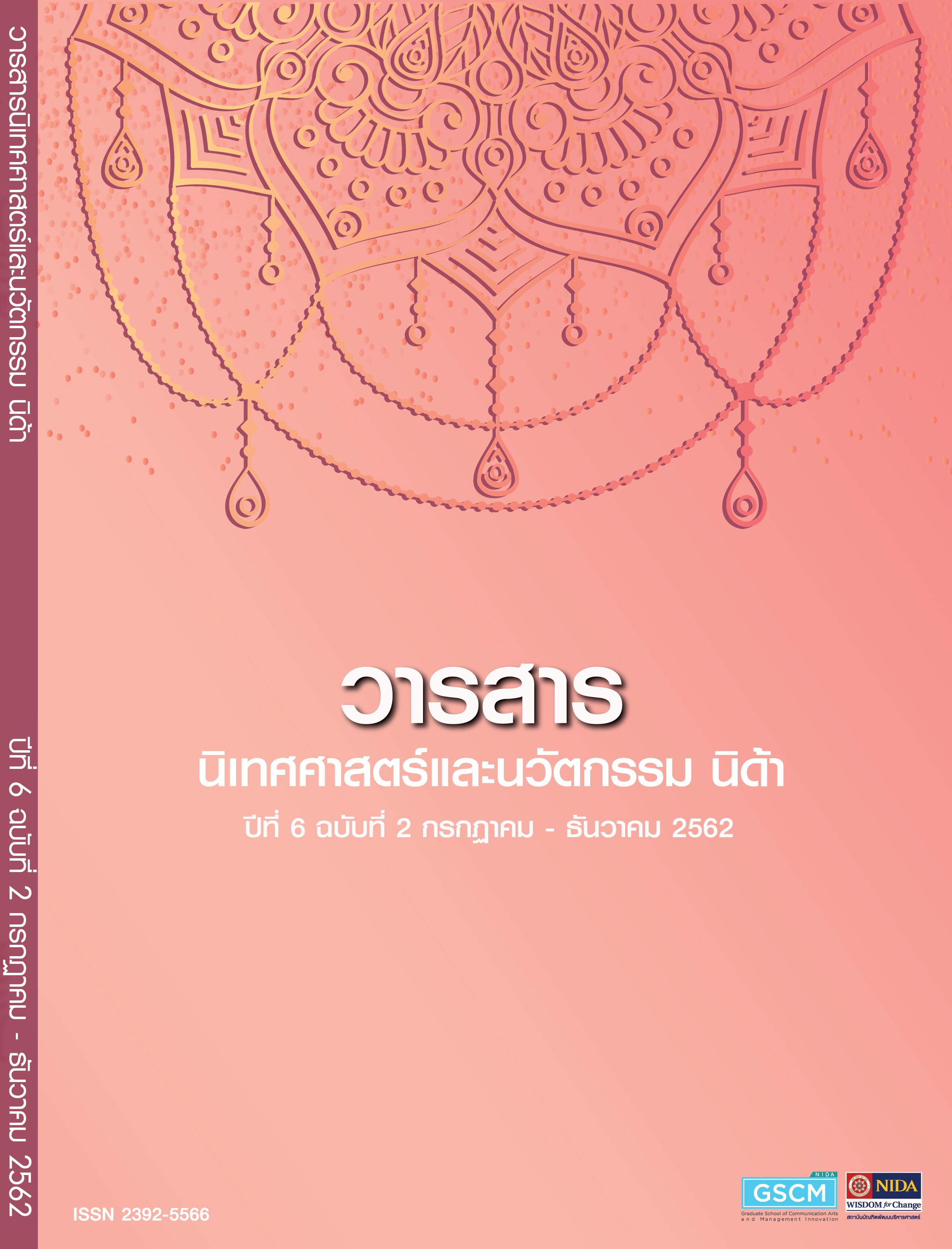Lifestyle, Media Exposure of Vlog, Credibility and Tourism Decision Making of Vlog Audience
Main Article Content
Abstract
The objectives of this study are as follows: (1) To study the relationship between lifestyle, media exposure of vlog, credibility and tourism decision making of vlog audience. (2) To identify factors affecting tourism decision making of vlog audience. This quantitative research was done by a survey method 400 sets of online survey questionnaires, distributed to vlog audiences from September to October 2018.
The result of the study, according to the analysis of the activities, interests and opinions, it could be grouped patterns of vlog audiences, which were: (1) Life is travel group (2) Family-oriented group (3) New social learner group (4) Technology person group (5) Arts person group and (6) Celebrity followers group. In terms of media exposure of vlog, the audiences have a high level of daily watching about travel vlog, watching for 30 minutes to 1 hour per time via YouTube to relieve stress and entertain. In terms of credibility, they have a high level of a dynamic information vlog and will focus on finding the information before tourism decision making.
Moreover, the hypothesis testing shown that lifestyle of vlog audiences were positively related to tourism decision making. Nevertheless, the study outcome proved that media exposure and credibility were positively related to tourism decision making as well. In particular, there were five factors that affected tourism decision making of vlog audience, listed in the order of importance, including (1) Credibility (2) Life is travel group (3) Family-oriented group (4) Media exposure group and (5) Technology person group.
Suggestions from the research found that although the vlog audiences have the most dynamic reliability, but the credibility in expertise, having an experience and knowledge about tourist attractions are also relatively low, so the research should study more about credibility, for example, how to increase the expertise of vlogger that the audience can be trusted at the same level as other aspects
Article Details
ข้อความและความเห็นในวารสารนิเทศศาสตร์และนวัตกรรม นิด้า เป็นของผู้เขียนแต่ละท่าน มิใช่ของคณะนิเทศศาสตร์และนวัตกรรมการจัดการ สถาบันบัณฑิตพัฒนบริหารศาสตร์
References
กฤษมันต์ วัฒนาณรงค์. (2554). นวัตกรรมและเทคโนโลยีเทคนิคศึกษา (พิมพ์ครั้งที่ 2). กรุงเทพฯ: ศูนย์ผลิตตำราเรียน มหาวิทยาลัยเทคโนโลยีพระจอมเกล้าพระนครเหนือ.
กิตติยา เด่นชัย. (2557). พฤติกรรมการใช้และการรับรู้ข้อมูลผ่านสื่อสังคมออนไลน์ที่มีผลต่อการตัดสินใจเลือกแหล่งท่องเที่ยวและสถานที่พักของนักท่องเที่ยวชาวไทยในเมืองพัทยา. (การค้นคว้าอิสระ ปริญญามหาบัณฑิต ไม่ได้ตีพิมพ์). มหาวิทยาลัยกรุงเทพ, กรุงเทพมหานคร.
กุลธิดา สายพรหม. (2558). กลยุทธ์การสร้างสรรค์ข่าวพยากรณ์อากาศทางโทรทัศน์ไทย (รายงานการวิจัย). กรุงเทพมหานคร: คณะเทคโนโลยีสื่อสารมวลชน มหาวิทยาลัยเทคโนโลยีราชมงคลพระนคร.
ชมพูนุท สารวานิชพิทักษ์. (2556). รูปแบบการดำเนินชีวิต การเปิดรับสื่อ และความภักดีของผู้ฟังรายการวิทยุกรีนเวฟ. (วิทยานิพนธ์ปริญญานิเทศศาสตรมหาบัณฑิต). จุฬาลงกรณ์มหาวิทยาลัย, กรุงเทพมหานคร.
ชาตินพคุณ วิไลวรรณ. (2552). ความน่าเชื่อถือของข้อมูลข่าวสารในเว็บบอร์ดบลูพลาเน็ท พันทิปดอทคอม. (วิทยานิพนธ์ปริญญามหาบัณฑิต ไม่ได้ตีพิมพ์). จุฬาลงกรณ์มหาวิทยาลัย,กรุงเทพมหานคร.
ชุลีพร ธานีรัตน์. (2556). รูปแบบการดำเนินชีวิต การเปิดรับข่าวสาร และพฤติกรรมการท่องเที่ยวตลาดย้อนยุคของนักท่องเที่ยวชาวไทย. (วิทยานิพนธ์ศิลปศาสตรมหาบัณฑิต ไม่ได้ตีพิมพ์).
สถาบันบัณฑิตพัฒนบริหารศาสตร์, กรุงเทพมหานคร.
ธนิตา คงชัย. (2559). รูปแบบการดำเนินชีวิต การเปิดรับข่าวสาร และพฤติกรรมการท่องเที่ยวเชิงสร้างสรรค์กับการใช้ประโยชน์ของนักท่องเที่ยวชาวไทย : ในบริบทเทศกาลดนตรี. (วิทยานิพนธ์ศิลปศาสตรมหาบัณฑิต ไม่ได้ตีพิมพ์). สถาบันบัณฑิตพัฒนบริหารศาสตร์, กรุงเทพมหานคร.
ภัสสร บุญพิทักษ์. (2560). ปัจจัยที่ส่งผลต่อความไว้วางใจในการตัดสินใจซื้อน้ำหอมแบรนด์เนมผ่านสื่อออนไลน์บนเฟซบุ๊ก. (การค้นคว้าอิสระ ศิลปศาสตรมหาบัณฑิต ไม่ได้ตีพิมพ์). สถาบันบัณฑิตพัฒนบริหารศาสตร์, กรุงเทพมหานคร.
เรข์ณพัศ ภาสกรณ์. (2554). รูปแบบการดำเนินชีวิต พฤติกรรมการบริโภค และการเปิดรับสื่อของชายรักชายในเขตกรุงเทพมหานคร. (วิทยานิพนธ์ปริญญานิเทศศาสตรมหาบัณฑิต ไม่ได้ตีพิมพ์). จุฬาลงกรณ์มหาวิทยาลัย, กรุงเทพมหานคร.
สาธิกานต์ บัวเทิง. (2560). อิทธิพลของบล็อกเกอร์ (Blogger) และการรีวิวผลิตภัณฑ์อาหารผ่านสื่อสังคมออนไลน์กับการตัดสินใจซื้อผลิตภัณฑ์ของผู้บริโภค. (การค้นคว้าอิสระ ศิลปศาสตรมหาบัณฑิต ไม่ได้ตีพิมพ์). สถาบันบัณฑิตพัฒนบริหารศาสตร์, กรุงเทพมหานคร.
สุภมาส อังศุโชติ, สมถวิล วิจิตวรรณา และรัชนีกูล ภิญโญภานุวัฒน์. (2552). สถิติวิเคราะห์สำหรับการวิจัยทางสังคมศาสตร์และพฤติกรรมศาสตร์ เทคนิคการใช้โปรแกรม Lisrel (พิมพ์ครั้งที่ 2). กรุงเทพฯ: เจริญดีมั่นคงการพิมพ์.
สำนักงานพัฒนาธุรกรรมทางอิเล็กทรอนิกส์ (องค์การมหาชน). (2560). รายงานผลการสำรวจพฤติกรรมผู้ใช้อินเทอร์เน็ตในประเทศไทยปี 2560. สืบค้นจาก https://www.etda.or.th
อภิชญา ณัฐพงศ์พฤทธิ์. (2558). รูปแบบการดำเนินชีวิต การรับรู้ข้อมูลการท่องเที่ยวจากสื่อออนไลน์ ความน่าเชื่อถือและพฤติกรรมการตัดสินใจการท่องเที่ยวต่างประเทศ. (วิทยานิพนธ์ศิลปศาสตรมหาบัณฑิต ไม่ได้ตีพิมพ์). สถาบันบัณฑิตพัฒนบริหารศาสตร์, กรุงเทพมหานคร.
Berlo, D. K., Lemert, J. B., & Mertz, R. J. (1969). Dimensions for Evaluating the Acceptability of Message Sources. Public Opinion Quarterly, 33(4), 563-576.
Cochran, W. G. (1953). Sampling Techiques. New York: John Wiley & Sons. Inc.
Crowel, H., Gribben, H., & Loo, J. (2014). Travel content takes off on YouTube. Retrieve from https://www.thinkwithgoogle.com/consumer-insights/travel-content-takes-off-on-youtube/
Devineni, M. (2017). 10 Different popular types of vlogs. Retrieved September 29, 2018, from http://vloglikepro.com/10-different-popular-types-vlogs
Hovland, C. I., Janis, I. L. & Kelley, H. H. (1953). Communication and persuasion: psychological studies of opinion change. New Haven: Yale University Press.
Jang, H. M., Jung, J. H., & Lee, W. L. (2011). The impact of Video quality and image size of The Effectiveness of online video advertising on YouTube. In American Academy of Advertising Conference Proceedings (p.154-154).
Kapper, J. T. (1960). The effects of mass communication. New York: The Free Press, pp19-26.
Klenosky, D.B. (2002). The “Pull” of tourism destinations: A means-end investigation. Journal of Travel Research, 40(2), 385-395.
Kotler, P., & Dupree, J. (1997). Marketing Management: Analysis, Planning, Implementation, and Control, Upper Saddle River, NJ: Prentice-Hall.
Mccombs, M. E., & Becker, L. E. (1979). Using Mass Communication Theory. Englewood Cliffs’ NJ : Princtice Hall.
Merill, J. C., & Lowenstein, R. L. (1971). Media, Message. An Men : New Perspectives in Communication. New York : David McKay Company Inc.
Michael M., Lugosi, P, & Ritchie, B. (2010). The Tourism and Leisure Experience: Consumer and Managerial Perspectives. Great Britain: MPG Books Group Ltd.
Plummer, J. T. (1974). The Concept and application of life style segmentation. Journal of Marketing, 38(1), 33-37.
Schmoll, G. A. (1977). Tourism Promotion. London: Tourism International Press.
Simkova, E. & Holzner, J. (2014). Motivation of Tourism Participants. Procedia - Social and Behavioral Sciences, 159(2014), 660-664.
World Tourism Organization. (2018). UNWTO Annual Report 2017. Retrieved from https://www.e-unwto.org/doi/book/10.18111/9789284419807


